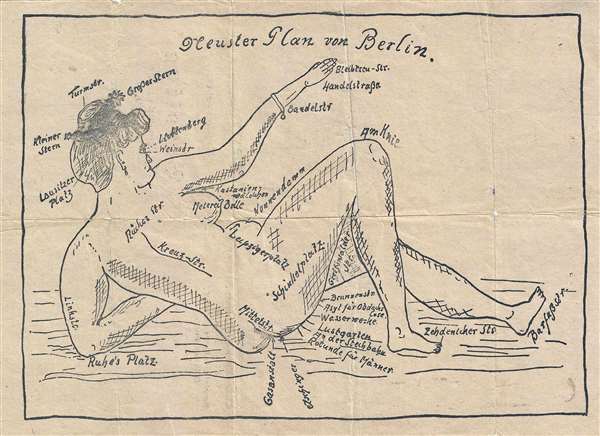This item has been sold, but you can get on the Waitlist to be notified if another example becomes available, or purchase a digital scan.
1919 Allegorical Map of Berlin as Berolina
NeusterPlanvonBerlin-bulow-1919$375.00

Title
Nuester Plan von Berlin. / Neuester Plan der Berolina im Revolationsjahr 1918-19.
1919 (dated) 6.75 x 9 in (17.145 x 22.86 cm)
1919 (dated) 6.75 x 9 in (17.145 x 22.86 cm)
Description
A previously unknown cartographic curiosity, this is a 1919 Oscar Bülow slightly bawdy allegorical map of Berlin, Germany, as Berolina, drawn to poke fun at the German Revolution of 1918-19. The humorous map is entitled 'Nuester Plan von Berlin' and features a reclining woman with strong Germanic features. Various locations on her body, particularly on her head and in her nether regions, are identified and associated with locations in Berlin ranging from generic locals such as the Gasanstalt (gasworks), and the Waasserwerke (waterworks), to the Lustgarten (pleasure garden), to specific realworld locations such as Turmstrasse, KleinerStern, Lausitzer Platz and Bandelstr. While some of the place names and the general structure of the image doubtless have some references to the events of the revolution, we have not been able to fully decipher the image, which will require considerable further research.
The German Revolution or November Revolution or Novemberrevolution was a civil conflict in the German Empire at the end of the First World War that resulted in the replacement of the German federal constitutional monarchy with a democratic parliamentary republic that later became known as the Weimar Republic. The revolutionary period lasted from November 1918 until the adoption in August 1919 of the Weimar Constitution. The roots of the revolution were dissatisfaction among the socialist-leaning populace and the 'old regime' aristocracy – who had just disastrously lost World War I. The Revolution resulted in the adoption of the Weimar Constitution and the election of the Weimar National Assembly which created a new social democratic system that did not fully displace the old aristocracy (although the Kaiser did abdicate), but rather integrated it more fully with the general populace.
Drawn and published by Oscar Bülow of Hanover, Germany.
The German Revolution or November Revolution or Novemberrevolution was a civil conflict in the German Empire at the end of the First World War that resulted in the replacement of the German federal constitutional monarchy with a democratic parliamentary republic that later became known as the Weimar Republic. The revolutionary period lasted from November 1918 until the adoption in August 1919 of the Weimar Constitution. The roots of the revolution were dissatisfaction among the socialist-leaning populace and the 'old regime' aristocracy – who had just disastrously lost World War I. The Revolution resulted in the adoption of the Weimar Constitution and the election of the Weimar National Assembly which created a new social democratic system that did not fully displace the old aristocracy (although the Kaiser did abdicate), but rather integrated it more fully with the general populace.
Drawn and published by Oscar Bülow of Hanover, Germany.
Cartographer
Oscar Bülow (fl. c. 1918 - 1919) was a German engraver and printer active in Hanover. He maintained offices at Calenberger Strasse 38. He advertised his specialty as Artistel Für Geist, Wit, und Humor. Little else is known of this elusive printer. More by this mapmaker...
Condition
Even toning. Wear and verso reinforcement on original fold lines.

